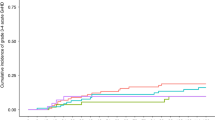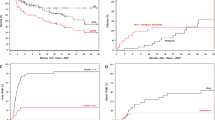Abstract
In myelofibrosis, the introduction of reduced-intensity conditioning (RIC) preceding allogeneic stem cell transplantation (SCT) resulted in lower transplant-related mortality rates compared with myeloablative conditioning. However, lowering the intensity of conditioning may increase the risk of graft failure in myelofibrosis, although hitherto this has not been indisputably proven. We here report the outcome of 53 patients who underwent allogeneic SCT with different conditioning regimens (RIC and non-myeloablative (NMA)) in three transplantation centers in the Netherlands. The cumulative incidence of graft failure within 60 days after SCT was high (28%), and this was primarily associated with the intensity of the conditioning regimen. Cumulative neutrophil engraftment at 60 days was lower in patients who received NMA conditioning compared with those who received RIC (56% vs 84%, P=0.03). Furthermore, of six patients who received a second transplantation after graft failure, the three patients with RIC regimens subsequently engrafted, whereas the three patients who received a second NMA regimen did not. This study indicates that in myelofibrosis, NMA regimens result in high engraftment failure rates. We propose the use of more intensive conditioning regimens, incorporating busulfan or melphalan.
This is a preview of subscription content, access via your institution
Access options
Subscribe to this journal
Receive 12 print issues and online access
$259.00 per year
only $21.58 per issue
Buy this article
- Purchase on Springer Link
- Instant access to full article PDF
Prices may be subject to local taxes which are calculated during checkout

Similar content being viewed by others
References
McLornan DP, Mead AJ, Jackson G, Harrison CN . Allogeneic stem cell transplantation for myelofibrosis in 2012. Br J Haematol 2012; 157: 413–425.
Abelsson J, Merup M, Birgegård G, WeisBjerrum O, Brinch L, Brune M et al. The outcome of allo-HSCT for 92 patients with myelofibrosis in the Nordic countries. Bone Marrow Transplant 2012; 47: 380–386.
Deeg HJ, Gooley TA, Flowers ME, Sale GE, Slattery JT, Anasetti C et al. Allogeneic hematopoietic stem cell transplantation for myelofibrosis. Blood 2003; 102: 3912–3918.
Ditschkowski M, Elmaagacli AH, Trenschel R, Gromke T, Steckel NK, Koldehoff M et al. DIPSS scores, pre-transplant therapy and chronic GVHD determine outcome after allogeneic hematopoietic stem cell transplantation for myelofibrosis. Haematologica 2012; 97: 1574–1581.
Guardiola P, Anderson JE, Bandini G, Cervantes F, Runde V, Arcese W et al. Allogeneic stem cell transplantation for agnogenic myeloid metaplasia: a European Group for Blood and Marrow Transplantation, Societe Francaise de Greffe de Moelle, Gruppo Italiano per il Trapianto del Midollo Osseo, and Fred Hutchinson Cancer Research Center Collaborative Study. Blood 1999; 93: 2831–2838.
Gupta V, Kroger N, Aschan J, Xu W, Leber B, Dalley C et al. A retrospective comparison of conventional intensity conditioning and reduced-intensity conditioning for allogeneic hematopoietic cell transplantation in myelofibrosis. Bone Marrow Transplant 2009; 44: 317–320.
Kerbauy DM, Gooley TA, Sale GE, Flowers ME, Doney KC, Georges GE et al. Hematopoietic cell transplantation as curative therapy for idiopathic myelofibrosis, advanced polycythemiavera, and essential thrombocythemia. Biol Blood Marrow Transplant 2007; 13: 355–365.
Patriarca F, Bacigalupo A, Sperotto A, Isola M, Soldano F, Bruno B et al. Allogeneic hematopoietic stem cell transplantation in myelofibrosis: the 20-year experience of the GruppoItalianoTrapianto di Midollo Osseo (GITMO). Haematologica 2008; 93: 1514–1522.
Stewart WA, Pearce R, Kirkland KE, Bloor A, Thomson K, Apperley J et al. The role of allogeneic SCT in primary myelofibrosis: a British Society for Blood and Marrow Transplantation study. Bone Marrow Transplant 2010; 45: 1587–1593.
Bacigalupo A, Ballen K, Rizzo D, Giralt S, Lazarus H, Ho V et al. Defining the intensity of conditioning regimens: working definitions. Biol Blood Marrow Transplant 2009; 15: 1628–1633.
Gupta V, Malone AK, Hari PN, Ahn KW, Hu ZH, Gale RP et al. Reduced-intensity hematopoietic cell transplantation for patients with primary myelofibrosis: a cohort analysis from the center for international blood and marrow transplant research. Biol Blood Marrow Transplant 2014; 20: 89–97.
Kröger N, Holler E, Kobbe G, Bornhauser M, Schwerdtfeger R, Baurmann H et al. Allogeneic stem cell transplantation after reduced-intensity conditioning in patients with myelofibrosis: a prospective, multicenter study of the Chronic Leukemia Working Party of the European Group for Blood and Marrow Transplantation. Blood 2009; 114: 5264–5270.
Patriarca F, Bacigalupo A, Sperotto A, Isola M, Bruno B, Van Lint MT et al. Outcome of allogeneic stem cell transplantation following reduced-intensity conditioninig regimen in patients with idiopathic myelofibrosis: the g.I.T.m.o. Experience. Mediterr J Hematol Infect Dis 2010; 2: e2010010.
Ballen KK, Shrestha S, Sobocinski KA, Zhang MJ, Bashey A, Bolwell BJ et al. Outcome of transplantation for myelofibrosis. Biol Blood Marrow Transplant 2010; 16: 358–367.
Robin M, Tabrizi R, Mohty M, Furst S, Michallet M, Bay JO et al. Allogeneic haematopoietic stem cell transplantation for myelofibrosis: a report of the SocieteFrancaise de Greffe de Moelle et de TherapieCellulaire (SFGM-TC). Br J Haematol 2011; 152: 331–339.
Rondelli D, Goldberg JD, Isola L, Price LS, Shore TB, Boyer M et al. MPD-RC 101 prospective study of reduced-intensity allogeneic hematopoietic stem cell transplantation in patients with myelofibrosis. Blood 2014; 124: 1183–1191.
Murata M, Nishida T, Taniguchi S, Ohashi K, Ogawa H, Fukuda T et al. Allogeneic transplantation for primary myelofibrosis with BM, peripheral blood or umbilical cord blood: an analysis of the JSHCT. Bone Marrow Transplant 2014; 49: 355–360.
Klampfl T, Gisslinger H, Harutyunyan AS, Nivarthi H, Rumi E, Milosevic JD et al. Somatic mutations of calreticulin in myeloproliferative neoplasms. N Engl J Med 2013; 369: 2379–2390.
Chi J, Nicolaou KA, Nicolaidou V, Koumas L, Mitsidou A, Pierides C et al. Calreticulin gene exon 9 frameshift mutations in patients with thrombocytosis. Leukemia 2014; 28: 1152–1154.
Tefferi A, Thiele J, Orazi A, Kvasnicka HM, Barbui T, Hanson CA et al. Proposals and rationale for revision of the World Health Organization diagnostic criteria for polycythemiavera, essential thrombocythemia, and primary myelofibrosis: recommendations from an ad hoc international expert panel. Blood 2007; 110: 1092–1097.
Passamonti F, Cervantes F, Vannucchi AM, Morra E, Rumi E, Pereira A et al. A dynamic prognostic model to predict survival in primary myelofibrosis: a study by the IWG-MRT (International Working Group for Myeloproliferative Neoplasms Research and Treatment). Blood 2010; 115: 1703–1708.
Bacigalupo A, Soraru M, Dominietto A, Pozzi S, Geroldi S, Van Lint MT et al. Allogeneic hemopoietic SCT for patients with primary myelofibrosis: a predictive transplant score based on transfusion requirement, spleen size and donor type. Bone Marrow Transplant 2010; 45: 458–463.
Tefferi A, Barosi G, Mesa RA, Cervantes F, Deeg HJ, Reilly JT et al. International Working Group (IWG) consensus criteria for treatment response in myelofibrosis with myeloid metaplasia, for the IWG for Myelofibrosis Research and Treatment (IWG-MRT). Blood 2006; 108: 1497–1503.
Zweegman S, Kessler FL, Celie JW, Janssen JJ, van den Born J, Schuurhuis GJ et al. Restoration of the human stem cell niche after stem cell transplantation. Blood 2009; 114: 5404–5406.
Dominici M, Rasini V, Bussolari R, Chen X, Hofmann TJ, Spano C et al. Restoration and reversible expansion of the osteoblastic hematopoietic stem cell niche after marrow radioablation. Blood 2009; 114: 2333–2343.
Olsson R, Remberger M, Schaffer M, Berggren DM, Svahn BM, Mattsson J et al. Graft failure in the modern era of allogeneic hematopoietic SCT. Bone Marrow Transplant 2013; 48: 537–543.
Kröger N, Zabelina T, Schieder H, Panse J, Ayuk F, Stute N et al. Pilot study of reduced-intensity conditioning followed by allogeneic stem cell transplantation from related and unrelated donors in patients with myelofibrosis. Br J Haematol 2005; 128: 690–697.
Alchalby H, Yunus DR, Zabelina T, Kobbe G, Holler E, Bornhäuser M et al. Risk models predicting survival after reduced-intensity transplantation for myelofibrosis. Br J Haematol 2012; 157: 75–85.
Rumi E, Pietra D, Pascutto C, Guglielmelli P, Martínez-Trillos A, Casetti I et al. Clinical effect of driver mutations of JAK2, CALR, or MPL in primary myelofibrosis. Blood 2014; 124: 1062–1069.
Jaekel N, Behre G, Behning A, Wickenhauser C, Lange T, Niederwieser D et al. Allogeneic hematopoietic cell transplantation for myelofibrosis in patients pretreated with the JAK1 and JAK2 inhibitor ruxolitinib. Bone Marrow Transplant 2014; 49: 179–184.
Acknowledgements
We kindly thank the following persons for their work concerning the mutational analyses: L van de Corput (Laboratory of Translational Immunology, University Medical Center Utrecht, Utrecht, the Netherlands), PJM Valk (Laboratory of Molecular diagnostics, Erasmus Medical Center, Rotterdam, the Netherlands), KGM Smolders and PA Merle (Department of Haematology, VU University Medical Center, Amsterdam, the Netherlands).
Author information
Authors and Affiliations
Corresponding author
Ethics declarations
Competing interests
The authors declare no conflict of interest.
Rights and permissions
About this article
Cite this article
Slot, S., Smits, K., van de Donk, N. et al. Effect of conditioning regimens on graft failure in myelofibrosis: a retrospective analysis. Bone Marrow Transplant 50, 1424–1431 (2015). https://doi.org/10.1038/bmt.2015.172
Received:
Revised:
Accepted:
Published:
Issue Date:
DOI: https://doi.org/10.1038/bmt.2015.172
This article is cited by
-
Allogeneic blood or marrow transplantation with haploidentical donor and post-transplantation cyclophosphamide in patients with myelofibrosis: a multicenter study
Leukemia (2022)
-
Impact of donor-derived CD34 + infused cell dose on outcomes of patients undergoing allo-HCT following reduced intensity regimen for myelofibrosis: a study from the Chronic Malignancies Working Party of the EBMT
Bone Marrow Transplantation (2022)
-
Myelofibrosis: let’s go high!
Bone Marrow Transplantation (2021)
-
Determinants of survival in myelofibrosis patients undergoing allogeneic hematopoietic cell transplantation
Leukemia (2021)
-
The European Society for Blood and Marrow Transplantation (EBMT) Consensus Guidelines for the Detection and Treatment of Donor-specific Anti-HLA Antibodies (DSA) in Haploidentical Hematopoietic Cell Transplantation
Bone Marrow Transplantation (2018)



